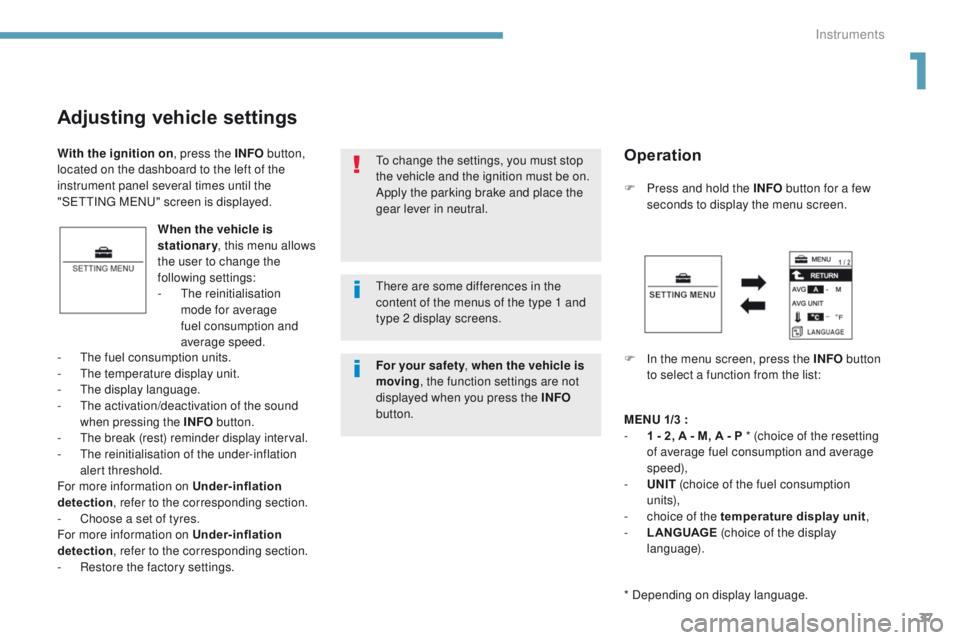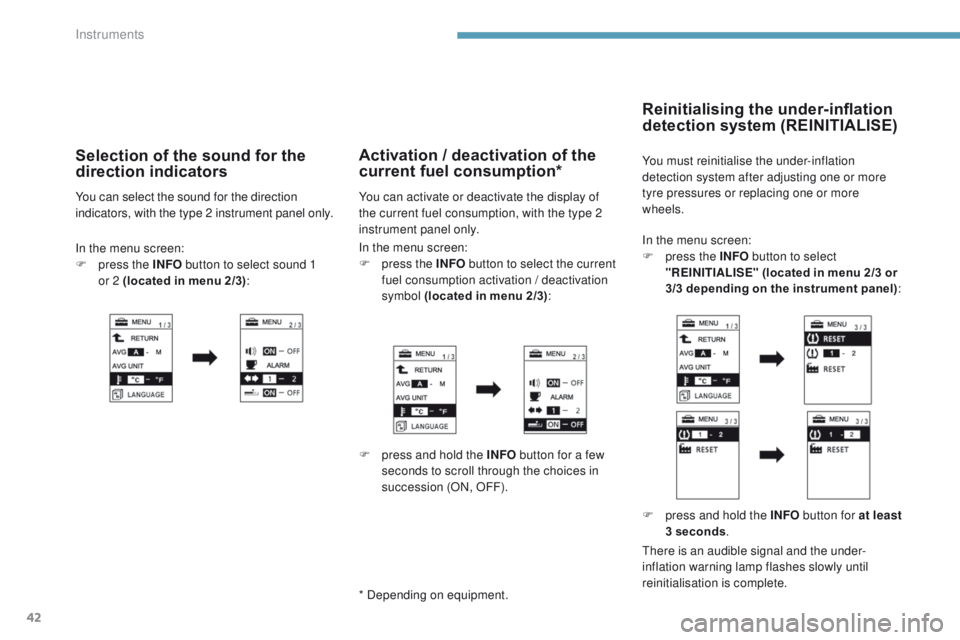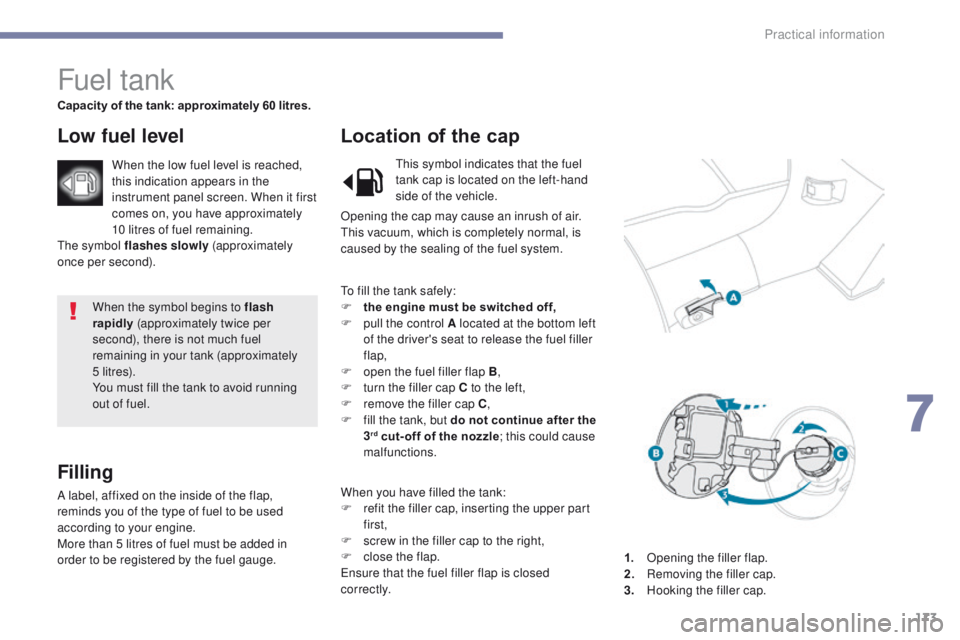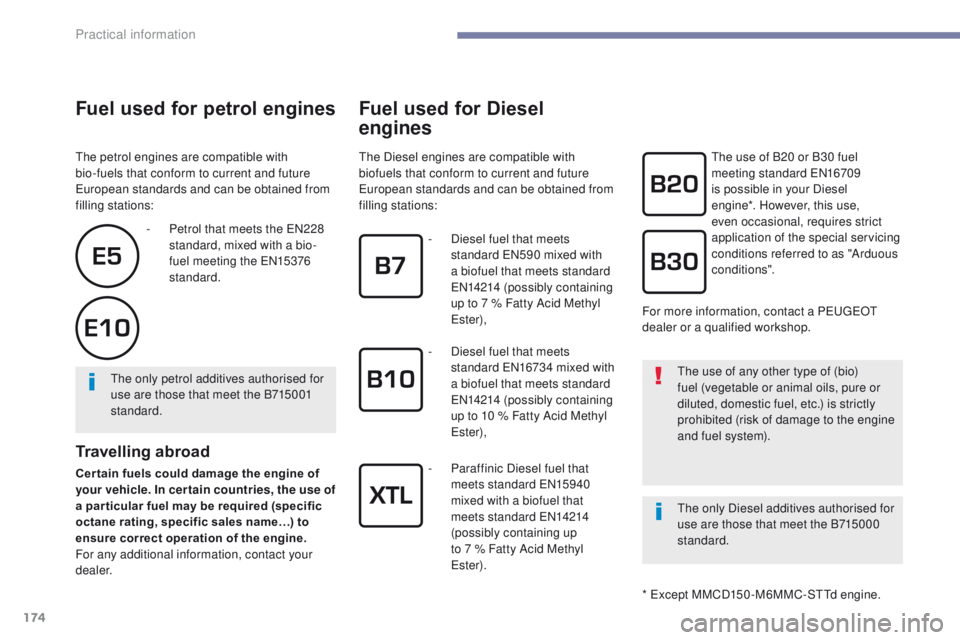2017 PEUGEOT 4008 fuel type
[x] Cancel search: fuel typePage 39 of 368

37
4008_en_Chap01_Instruments-de-bord_ed01-2016
Adjusting vehicle settings
When the vehicle is
stationary, this menu allows
the user to change the
following settings:
-
t
h
e reinitialisation
mode for average
fuel consumption and
average speed. F
P
ress and hold the INFO
button for a few
seconds to display the menu screen.
F
I
n the menu screen, press the INFO button
to select a function from the list:
-
t
h
e fuel consumption units.
-
t
h
e temperature display unit.
-
t
h
e display language.
-
t
he
activation/deactivation of the sound
when pressing the INFO button.
-
t
he
break (rest) reminder display interval.
-
t
h
e reinitialisation of the under-inflation
alert threshold.
For more information on Under-inflation
detection , refer to the corresponding section.
-
C
hoose a set of tyres.
For more information on Under-inflation
detection , refer to the corresponding section.
-
R
estore the factory settings.
to c
hange the settings, you must stop
the vehicle and the ignition must be on.
Apply the parking brake and place the
gear lever in neutral.
With the ignition on
, press the INFO button,
located on the dashboard to the left of the
instrument panel several times until the
"S
e
tt
I
N
g
M
eNu" s
creen is displayed.
Operation
MENU
1/3 :
- 1 - 2 , A - M, A - P * (choice of the resetting
of average fuel consumption and average
speed),
-
UN
IT (choice of the fuel consumption
un i t s),
-
c
hoice of the temperature display unit ,
-
L
ANGUAGE (choice of the display
language).
* Depending on display language.
th
ere are some differences in the
content of the menus of the type 1 and
type 2 display screens.
For your safety, when the vehicle is
moving , the function settings are not
displayed when you press the INFO
button.
1
Instruments
Page 44 of 368

42
In the menu screen:
F p ress the INFO button to select
"REINITIALISE" (located in menu 2/3 or
3/3 depending on the instrument panel) :
Reinitialising the under-inflation
detection system (REINITIALISE)
You must reinitialise the under-inflation
detection system after adjusting one or more
tyre pressures or replacing one or more
wheels.
F
p
ress and hold the INFO button for at least
3 seconds .
ther
e is an audible signal and the under-
inflation warning lamp flashes slowly until
reinitialisation is complete.
In the menu screen:
F
p
ress the INFO button to select the current
fuel consumption activation / deactivation
symbol (located in menu 2/3) :Activation / deactivation of the
current fuel consumption*
You can activate or deactivate the display of
the current fuel consumption, with the type 2
instrument panel only.
F
p
ress and hold the INFO button for a few
seconds to scroll through the choices in
succession (ON, OFF).
* Depending on equipment.
In the menu screen:
F p ress the INFO button to select sound 1
or
2 (located in menu 2/3) :
Selection of the sound for the
direction indicators
You can select the sound for the direction
indicators, with the type 2 instrument panel only.
Instruments
Page 175 of 368

173
4008_en_Chap07_info-pratiques_ed01-2016
When the symbol begins to flash
rapidly (approximately twice per
second), there is not much fuel
remaining in your tank (approximately
5 li t r e s).
You must fill the tank to avoid running
out of fuel.
Fuel tank
Capacity of the tank: approximately 60 litres.
Low fuel level
Filling
A label, affixed on the inside of the flap,
reminds you of the type of fuel to be used
according to your engine.
More than 5 litres of fuel must be added in
order to be registered by the fuel gauge.
Location of the cap
When the low fuel level is reached,
this indication appears in the
instrument panel screen. When it first
comes on, you have approximately
10 litres of fuel remaining.
th
e symbol flashes slowly (approximately
once per second).
1.
O
pening the filler flap.
2.
R
emoving the filler cap.
3.
H
ooking the filler cap.
to f
ill the tank safely:
F
t
he engine must be switched off,
F
p
ull the control A located at the bottom left
of the driver's seat to release the fuel filler
flap,
F
o
pen the fuel filler flap B,
F
t
urn the filler cap C to the left,
F
r
emove the filler cap C,
F
f
ill the tank, but do not continue after the
3
rd cut- off of the nozzle ; this could cause
malfunctions.
When you have filled the tank:
F
r
efit the filler cap, inserting the upper part
first,
F
s
crew in the filler cap to the right,
F
c
lose the flap.
en
sure that the fuel filler flap is closed
c o r r e c t l y.
th
is symbol indicates that the fuel
tank cap is located on the left-hand
side of the vehicle.
Opening the cap may cause an inrush of air.
th
is vacuum, which is completely normal, is
caused by the sealing of the fuel system.
7
Practical information
Page 176 of 368

174
4008_en_Chap07_info-pratiques_ed01-2016
Fuel used for petrol engines
the petrol engines are compatible with
bio-fuels that conform to current and future
eu
ropean standards and can be obtained from
filling stations:
Travelling abroad
Cer tain fuels could damage the engine of
your vehicle. In cer tain countries, the use of
a par ticular fuel may be required (specific
octane rating, specific sales name…) to
ensure correct operation of the engine.
For any additional information, contact your
dealer. -
Pe
trol that meets the e
N
228
standard, mixed with a bio-
fuel meeting the e
N
15376
standard.
th
e only petrol additives authorised for
use are those that meet the B715001
standard.
Fuel used for Diesel
engines
the Diesel engines are compatible with
biofuels that conform to current and future
eu
ropean standards and can be obtained from
filling stations:th e use of B20 or B30 fuel
meeting standard eN 16709
is possible in your Diesel
engine*. However, this use,
even occasional, requires strict
application of the special servicing
conditions referred to as "Arduous
conditions".
-
D
iesel fuel that meets
standard
e
N
590 mixed with
a biofuel that meets standard
eN
14214 (possibly containing
up to 7 % Fatty Acid Methyl
es
ter),
-
D
iesel fuel that meets
standard
e
N
16734 mixed with
a biofuel that meets standard
eN
14214 (possibly containing
up to 10 % Fatty Acid Methyl
es
ter),
-
P
araffinic Diesel fuel that
meets standard
e
N
15940
mixed with a biofuel that
meets standard
e
N
14214
(possibly containing up
to 7 % Fatty Acid Methyl
es
ter). For more information, contact a P
e
uge
Ot
dealer or a qualified workshop.
th
e use of any other type of (bio)
fuel (vegetable or animal oils, pure or
diluted, domestic fuel, etc.) is strictly
prohibited (risk of damage to the engine
and fuel system).
th
e only Diesel additives authorised for
use are those that meet the B715000
standard.
*
e
x
cept MMCD150 -M6MMC-S
t
t
d e
ngine.
Practical information
Page 221 of 368

219
4008_en_Chap09_caracteristiques-techniques_ed01-2016
* the maximum power corresponds to the value type-approved on a test bed, under conditions defined in eu ropean legislation
(Directive 1999/99/eC ).
engines and gearboxes
.../S: model fitted with the Stop & Start (AS&g) f unction.
PETROL ENGINES
1.6 litre 1152.0 litre 150
GEARBOXES Manual
(5-speed) CV
t(
6-speed)
Manual
(5-speed) CV
t(
6-speed)
Model codes : BU... NKZ0
NKZ0/S NKZ9
NKZ9/S AFYR
AFZ7 AFYV
AFZM AFYT
AFZH AFZ9 AFYW
AFZP
AFZC
Transmission mode 2WD2WD2WD 4WD2WD 4WD
Cubic capacity (cc) 1 5901 998
Bore x stroke (mm) 75 x 9086 x 86
Max power*: eu standard (kW)
86 113
Max power engine speed (rpm) 6 0006 000
Max torque: eu standard (Nm)
15 4 19 9
Max torque engine speed (rpm) 4 0004 200
Fuel
u
nleaded
u
nleaded
Catalytic converter Ye sYe s
OIL CAPACITY (in litres)
eng
ine (with filter replacement)
4.24.3
9
technical data
Page 227 of 368

225
4008_en_Chap09_caracteristiques-techniques_ed01-2016
* the maximum power corresponds to the value type-approved on a test bed, under conditions defined in eu ropean legislation
(Directive 1999/99/eC ).
engines and gearboxes
.../S and .../1S : model fitted with the Stop & Start (AS&g) f unction.
DIESEL ENGINES
1.6 HDi 115 S&S1.8 HDi 140
GEARBOXES Manual
(6-speed) Manual
(6-speed)
Model codes: BU... 9HD5/S
9HD5/1S 9HDK/S
9HDK /1S 6HYG
Transmission mode 2WD4WD4WD
Cubic capacity (cc) 1 5601 798
Bore x stroke (mm) 77 x 88.383 x 83.1
Max power*: eu standard (kW)
84103
Max power engine speed (rpm) 3 6004 000
Max torque: eu standard (Nm)
270290
Max torque engine speed (rpm) 1 7502 000 to 3 000
Fuel DieselDiesel
Catalytic converter Ye sYe s
Particle filter (FAP) Ye sYe s
OIL CAPACITY (in litres)
eng
ine (with filter replacement)
3.755.3
9
technical data
Page 235 of 368

233
4008_en_Chap09_caracteristiques-techniques_ed01-2016
Identification markingsVarious visible markings for the identification and tracing of your vehicle.
A.
M
anufacturer's plate.
I
t is riveted to the right-hand centre pillar
and carries the following information:
-
manufacturer,
-
eu type approval number,
-
v
ehicle identification number (VIN),
-
g
ross vehicle weight,
-
g
ross train weight,
-
m
aximum front axle weight,
-
m
aximum rear axle weight.
th
e tyre pressures must be checked
when the tyres are "cold", at least once
a month (vehicle having been stationary
for 1 hour or after a journey of less than
6 miles (10 km) at moderate speed).
If the tyre pressures are too low, this
increases fuel consumption.
B.
T
yre label.
t
h
is label is affixed to the driver's side
centre pillar and carries the following
information:
-
t
yre sizes,
-
t
yre pressures.C.
V
ehicle Identification Number (VIN)
under the bonnet.
t
h
is number is engraved on the bodywork
near the damper support.
th
e original tyres fitted to the vehicle
may have a load index or speed rating
higher than those given on the label;
this has no effect on the inflation
pressures.
9
technical data